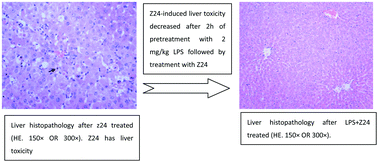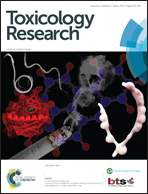Regulation of bacterial lipopolysaccharide in liver toxicity caused by chlorpromazine and Z24 in Sprague-Dawley rats
Abstract
Objective To determine the characteristics and manifestations of liver toxicity induced by chlorpromazine (CPZ, a phenothiazine antipsychotic drug) and Z24 (an anticancer candidate drug) and to study the relationship between short-term inflammation and drug-induced liver toxicity through monitoring inflammation induced by low-dose lipopolysaccharides (LPS) and the hepatic toxicants CPZ and Z24. Methods A specific inhibitor of Kupffer cells, GdCl3, was used to probe the role of these cells in the development of liver toxicity. Interleukin-1 alpha (IL-1α) was evaluated to study the roles of hepatic non-parenchymal cells and inflammatory mediators in liver toxicity induced by CPZ and Z24, as well as the effect of LPS on drug-induced liver toxicity. In addition, the mechanism, process, steps and pathways of the influence exerted by hepatic non-parenchymal cells and inflammatory mediators are discussed. Results Treatment with 75 mg kg−1 CPZ caused significant changes in the blood biochemical index of liver toxicity, but this dosage did not have an effect on liver pathology. When 75 mg kg−1 CPZ was administered 2 h after an inflammatory response had been induced by 2 mg kg−1 LPS, the blood biochemical index of liver toxicity increased further, and liver injury lesions occurred. Treatment with 200 mg kg−1 Z24 significantly increased the blood biochemical index of liver toxicity and induced a significant pathological change in liver injuries. However, after 2 h of pretreatment with 2 mg kg−1 LPS followed by treatment with Z24, the blood biochemical index was normal, and pathological change was significantly reduced. Pretreatment with 10 mg kg−1 GdCl3 significantly inhibited the enhancement of CPZ-induced liver toxicity by LPS; however, the same treatment did not alter the protective effect of LPS against Z24-induced liver toxicity. Two hours of pretreatment with 1.25 μg kg−1 IL-1α significantly antagonized the liver toxicity induced by Z24; however, compared with the control group, a degree of liver toxicity was still observed. Conclusions When an organism is experiencing an inflammatory response, activation of Kupffer cells enhances CPZ-induced liver toxicity. The inflammatory response induced by LPS could be used to establish and study a screening model for idiosyncratic liver toxicity. Under inflammatory response conditions, activating endothelial cells and IL-1α might have a protective effect against Z24-induced liver toxicity.


 Please wait while we load your content...
Please wait while we load your content...